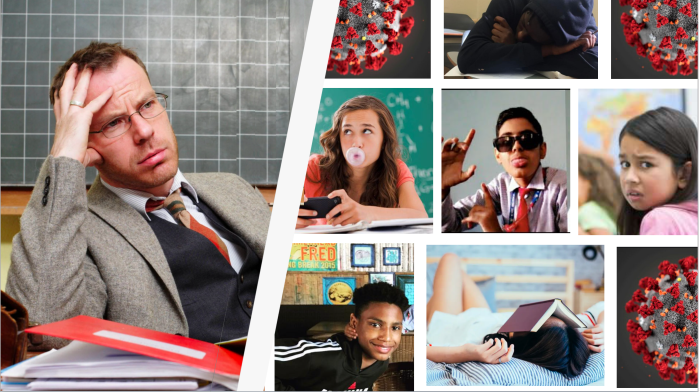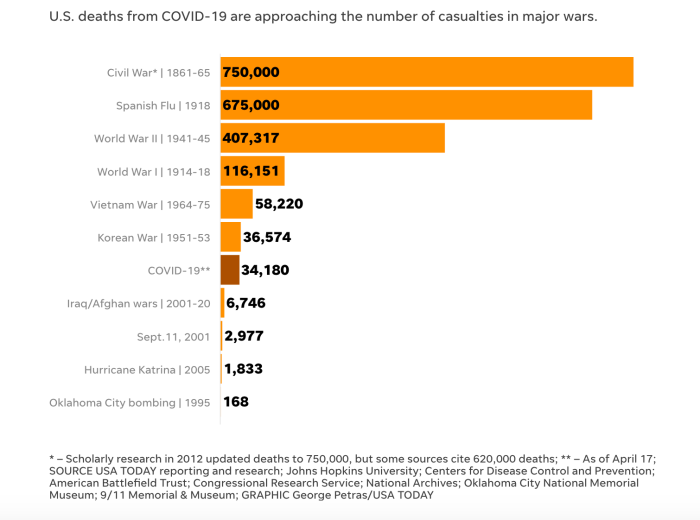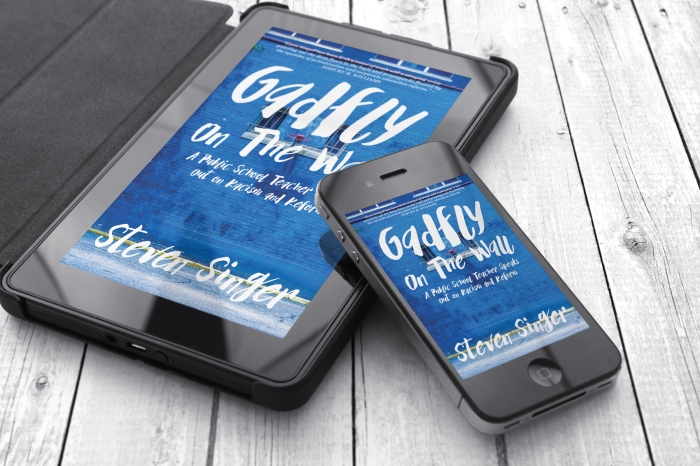
There are at least two silver linings to the current Coronavirus catastrophe for education.
One – with nearly all public schools closed, March was the first month since 2002 without a school shooting.
Two – districts nationwide cancelled high stakes standardized tests in April and May.
Taken together, these are two victories that no one could have predicted before November.
Gun safety restrictions remain laughably lax in the US compared to the rest of the world. And our system’s reliance on high stakes testing to hold schools and teachers accountable for economic inequalities and racially biased standards has been thoroughly criticized for nearly a century.
In short, the virus succeeded where policy did not.
The pandemic’s other effects have been more damaging as students, parents and teachers have struggled to move education online at home.
Teachers are seeing high absences especially among poor, underprivileged and special needs children. Not to mention worries about the quality and depth of education provided virtually and the stress it places on families.
To make matters worse, the situation seems likely to continue in some form when next school year begins in the fall.
With the COVID-19 virus likely to endure spreading unchecked due to a lack of adequate health screenings, the time it takes to make a vaccine, and an unwillingness by the government to save everyday people from the economic consequences of a nearly stopped economy, not to mention an increasing unwillingness among people to continue thorough social distancing procedures, schools may be left to solve the crisis themselves.
There’s been talk that when schools start up in August and September they may simply continue with cyber curriculum. Or they may open the physical buildings with safety protocols including half day classes of smaller size to keep students a safe distance apart.
In any case, the question of standardized testing arises again with a vengeance.
While there is some wiggle room, federal law (The Every Student Succeeds Act) requires all public school students be given standardized tests in grades 3-8 and once in high school.
The U.S. Department of Education waived that mandate this year because of the virus.
That was great news – a sound decision from a government agency known more for market solutions than rationality.
The question remains: why did the department do it?
Whether staffed by Democrats or Republicans, this doesn’t sound like them.
Why was this exception made and will it be extended again given that the circumstances may be little different in 2020-21 than they were in 2019-20?
The answer seems to be rooted in the tests, themselves, and the economic circumstances which create and sustains them.
WHY TESTS WERE CANCELLED
In late March, Education Secretary Betsy DeVos said that her department would streamline the paperwork for states to request a waiver allowing them not to give high stakes testing this year and that the government wouldn’t use this year’s testing data in future school accountability ratings.
“Students need to be focused on staying healthy and continuing to learn. Teachers need to be able to focus on remote learning and other adaptations. Neither students nor teachers need to be focused on high-stakes tests during this difficult time.”
How did we get here?
Well, imagine a world where this didn’t happen.
Before DeVos made her statement, some states like Colorado and Texas had already eliminated testing requirements without waiting for a response from DeVos.
If the federal government hadn’t answered these requests in the affirmative, it would have had to engage in an open power struggle with the states over control of public schooling.
This would be especially damaging for a Republican administration because of the party’s stance on state’s rights.
However, even if we put aside this power dynamic, the decision was inevitable.
CORPORATIONS FIRST
All of these assessments are the property of private corporations. These include Harcourt Educational Measurement, CTB McGraw-Hill, Riverside Publishing (a Houghton Mifflin company), and NCS Pearson.
States purchase the right to use these tests but assessment material is the ideological property of the parent corporation. And so they want it guarded from theft.
That’s why nearly all high stakes testing requires proctors – people whose job it is to set up, monitor and secure the testing environment. They make sure test takers don’t cheat, but they also are responsible for ensuring no information about specific test questions leaves the assessment environment.
This is true for standardized assessments at the K-12 level as well as college and certification tests.
I know because I’ve spent every year of my teaching career employed as a proctor throughout most of April as my students take the Pennsylvania System of School Assessments (PSSA) tests. But also when I got my degree I had to go to a designated testing center where I could be monitored as I took a series of assessments necessary to get my certification.
I had to sign in, empty my pockets including giving over my cell phone, and submit to being observed by the proctors and video surveillance. I even had to sign out and back in when I needed to use the restroom.
With physical classrooms closed, there was simply no way effectively to do this.
The College Board tried anyway with an abbreviated Advanced Placement test taken online from home this month to disastrous results – glitches, server issues and a failure by the organization to take responsibility.
However, the problem isn’t essentially technological. These assessments could be given online. Many districts do exactly that, but with teachers in the room acting as proctors.
The technological infrastructure may not yet be in place for widespread virtual testing, but that’s not an insurmountable hurdle.
Test security is a much stickier issue – without real, live people policing the environment, testing information would be at risk.
Rival companies could get access to trade secrets. The value of scores could come under scrutiny due to concerns of student cheating. And the tests, themselves, would for the first time be visible to parents and the general public.
TESTING SECRECY
As a classroom teacher, I get to see these infernal tests. I get to see the questions.
They are not good. They are not well-written, well considered, developmentally appropriate or even good at evaluating student understanding of the knowledge they claim to be assessing.
But up to this point, anyone who gets to see the tests is sworn to secrecy including the students.
The kids taking these exams – regardless of age – are no longer treated as children. They are clients entering into a contract.
At the start of these tests, they are warned of the legal consequences of violating the terms of this agreement.
THE PSSAS
In particular,the PSSAs require students to read the following warning on the first day of the assessment:
DO NOT PHOTOGRAPH, COPY OR REPRODUCE MATERIALS FROM THIS ASSESSMENT IN ANY MANNER. All material contained in this assessment is secure and copyrighted material owned by the Pennsylvania Department of Education. Copying of material in any manner, including the taking of a photograph, is a violation of the federal Copyright Act. Penalties for violations of the Copyright Act may include the cost of replacing the compromised test item(s) or a fine of no less than $750 up to $30,000 for a single violation. 17 U.S.C. $ 101 et seq
So the first act of testing is a threat of legal consequences and possible fines.
In the commonwealth, we also force kids to abide by a specific code of conduct for test takers. They must enter a quasi-legal relationship before they are even permitted to begin.
Much of this code is common sense. Get a good night’s sleep. Fill in bubbles completely using a number two pencil.
But some of it is deeply disturbing.
For example, students are told to “report any suspected cheating to your teacher or principal.”
They have to agree to be an informer or snitch to a government agency. My students aren’t old enough to vote or even drive a car, but they are directed to collaborate with the government against their classmates.
In addition, they are told NOT to:
-talk with others about questions on the test during or after the test.
-take notes about the test to share with others.
Students are compelled into a legalistic vow that they won’t break this code. On the test, itself, we make them fill in a bubble next to the following statement:
By marking this bubble I verify that I understand the “Code of Conduct for Test Takers” that my Test Administrator went over with me.
As a test administrator, I am not allowed to move on until all students have filled in that bubble.
Technically, we are not making them promise TO ABIDE by the code of test takers. Perhaps we lack that legal authority. We are, however, making them swear they understand it. Thus we remove ignorance as an excuse for noncompliance.
As a proctor, I have to sign a similar statement that I understand the “Ethical Standards of Test Administration.” Again, much of this is common sense, but it includes such statements as:
DO NOT:
-Discuss, disseminate or otherwise reveal contents of the test to anyone.
-Assist in, direct, aid, counsel, encourage, or fail to report any of the actions prohibited in this section.
So even teachers technically are not allowed to discuss the test and should report students or colleagues seen doing so.
And according to the “Pennsylvania System of School Assessment Directions for Administration Manuel”:
Those individuals who divulge test questions, falsify student scores, or compromise the integrity of the state assessment system in any manner will be subject to professional disciplinary action under the Professional Educator Discipline Act, 24 P.S. $ 2070. 1a et seq, including a private reprimand, a public reprimand, a suspension of their teaching certificate(s), a revocation of their teaching certificate(s), and/or a suspension or prohibition from being employed by a charter school. [emphasis added]
CORPORATE VULNERABILITY
If students were allowed to take these tests unsupervised at home, all of this legal protection would disappear.
The corporations would be much more exposed and defenseless.
THAT’S why the tests were cancelled this year.
It wasn’t because anyone rethought the value of high stakes tests – though they should have. It wasn’t because anyone had considered standardized testing’s history in the eugenics movement – which they should have. It wasn’t because anyone was worried that giving these tests would take away precious academic time – though they should have.
It was to protect the business interests that would be at risk otherwise.
THE DYSTOPIAN TESTING FUTURE
The need for proctors is a problem that the testing companies know about and are working to eliminate.
In fact, they’ve been trying to line things up in their favor for years.
Their answer is something called Competency Based Education (CBE) or Proficiency Based Education (PBE). But don’t let these names fool you. It has nothing to do with making children competent or proficient in anything except taking computer-based tests.
Paradoxically, it’s sold as a reduction in testing, but really it’s about changing the paradigm.
It’s a scheme that ed tech corporations privately call stealth assessments. Students take high stakes tests without even knowing they are doing it. They’re asked the same kinds of multiple-choice nonsense you’d find on state mandated standardized assessments but programmers make it look like a game.
This safeguards the tests because kids aren’t aware of being tested. Constant micro-assessments blend in with test prep curriculum until there is little to no difference between the two. Academics gets dumbed down to the level of multiple choice and critical thinking is redefined as asking “What does the questioner want me to think?”
Yet the results could still be used to label schools “failing” regardless of how under-resourced they are or how students are suffering the effects of poverty. Mountains of data will still be collected on your children and sold to commercial interests to better market their products.
But that’s just how it is used in schools today.
The potential is to make this a replacement for physical schools.
It’s a disaster capitalism reform tailor made for the Coronavirus age, but not yet ready for large scale implementation.
Imagine a world where there are no schools – just free range children plopped in front of a computer or an iPad and told to go learn something.
No schools, no teachers, just gangs of students walking the streets, stopping along the way to thumb messages to each other on social media, play a video game or take an on-line test.
That’s the world many ed tech entrepreneurs are trying to build.
One thing they need is a pet policy of DeVos and the Trump administration – Education Savings Accounts (ESAs).
Normally, the federal, state and local government collect taxes to fund an individual child’s education, which is then spent at a public or charter school.
However, ESAs would allow that money to go elsewhere. It could go to funding the tuition at a private or parochial school like a traditional school voucher.
Or it could be used for discrete education services provided by the ed tech industry.
It’s almost like homeschooling – without a parent or guardian in charge.
The idea is often called a learning ecosystem.
But it’s just a single person cyber school with little to no guiding principles, management or oversight.
Education is reduced to a series of badges students can earn by completing certain tasks.
Reading a book or an article gives you a badge. Answering a series of multiple-choice questions on a reading earns you more badges. And if you’ve completed a certain task satisfactorily, you can even earn a badge by teaching that same material to others.
It’s the low wage gig economy applied to education. Children would bounce from a few hours of Khan Academy videos here to a software package there and Voila! “Modern” education!
And as an added benefit, the badge structure creates a market where investors can bet and profit off of who gains badges and to what degree on the model of crypto-currencies like Bitcoin!
Make no mistake, it’s not about improving the quality of education. It’s about providing the cheapest possible alternative and selling it to the rubes as innovation.
It’s school without the school or teachers.
CONCLUSIONS
This is where the testing industry is going.
This is where we would be today if the legal framework were in place and the technology were widespread, adequate and capable of safeguarding corporate intellectual property without the need for test proctors.
In the short term, this is good news.
As long as the pandemic keeps school buildings closed or keeps them running at less than capacity, the chances of mandating high stakes testing during the crisis goes down.
On the flip side that’s detrimental to student learning in the here and now, but it does offer hope for the future. It at least opens the door to cancelling high stakes testing in 2020-21 like we did this year. And the longer we keep those tests at bay, the greater likelihood they will go away for good.
However, the people at the testing corporations are far from stupid. They know that each year we forgo the tests proves how unnecessary they are.
A coalition of six neoliberal organizations warned against cancelling the tests nationwide in March.
“As the coronavirus pandemic evolves on a daily basis, it would be premature to issue blanket national waivers from core components of the law. Thus, case-by-case consideration of each state’s needs is, at this time, most appropriate,” said a letter signed by testing industry lobbyists including John King, the former secretary of education and head of the Education Trust.
They have the future mapped out – a future with immense earnings for their companies and shareholders.
We must be fully aware of what is happening and why if we are to have any chance of opposing the next disaster and coming out of the current crisis with better school policy than we went in.
If we are to safeguard an authentic education for our children, we must learn these lessons, ourselves, now.
Like this post? You might want to consider becoming a Patreon subscriber. This helps me continue to keep the blog going and get on with this difficult and challenging work.
Plus you get subscriber only extras!
Just CLICK HERE.

I’ve also written a book, “Gadfly on the Wall: A Public School Teacher Speaks Out on Racism and Reform,” now available from Garn Press. Ten percent of the proceeds go to the Badass Teachers Association. Check it out!



















